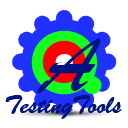Main menu
Tool Scope
Testing Methods
Testing Objectives
- API-testing
- Application-Life-Cycle-Tracking
- Application-Logic-Testing
- Back-End-Service
- Back-end-Stress
- Banking-Process-validation
- Big-Data-Testing
- Binary-Static-Analysis
- Binding-Unit-Testing
- Code-Analysis
- Code-Coverage-testing
- Code-Review
- Code-Tracability
- Coding-Standards-verfication
- Cross-Platform-Testing
- Cross-Browser-testing
- Data-Flow-Analysis
- Data-Interface-Testing
- Data-Migration-Testing
- Data-Warehouse-Testing
- DataBase-testing
- Database-Upgrade-Testing
- Desktop-testing
- EMail-Testing
- Embedded--Software
- ETL-Testing
- Http-Unit-Testing
- Image-Based-Testing
- Image-Comparison
- Interoperability-testing
- Java-testing
- Load-Capabilities
- Log-Tracking
- Memory-Analysis
- Memory-Leak-Detection
- Message-testing
- Metrics-Analysis
- Mobile-Testing
- Network-testing
- Object-Based-Testing
- OWASP-Top10-Testing
- Pair-Wise-Analysis
- Payload-Validation
- Penetration-testing
- Performance-Analysis
- Plugin-testing
- Protocol-Testing
- Runtime-Error-Detection
- SANS-CWE-Top25
- SAP-Testing
- Security-Testing
- SEO
- Server-testing
- SOA-testing
- Static-Code-Analysis
- Stress-Testing
- Test-Cases-Statistics
- Test-Design
- Test-Embedded-systems
- UI-testing
- Uptime-Testing
- WCF-services
- Web-Monitoring
- Web-Services
- Web-testing
- Website-Speed-Testing
You are here
Hybrid Testing
Overview
The hybrid Test Automation Framework is what most frameworks evolve into over time and multiple projects. The most successful automation frameworks generally accommodate both Keyword-driven testing as well as Data-driven testing. This allows data driven scripts to take advantage of the powerful libraries and utilities that usually accompany a keyword driven architecture. The framework utilities can make the data driven scripts more compact and less prone to failure than they otherwise would have been. The utilities can also facilitate the gradual and manageable conversion of existing scripts to keyword driven equivalents when and where that appears desirable. On the other hand, the framework can use scripts to perform some tasks that might be too difficult to re-implement in a pure keyword driven approach, or where the keyword driven capabilities are not yet in place.
The Framework
The framework is defined by the Core Data Driven Engine, the Component Functions, and the Support Libraries (see adjacent picture) . While the Support Libraries provide generic routines useful even outside the context of a keyword driven framework, the core engine and component functions are highly dependent on the existence of all three elements. The test execution starts with the LAUNCH TEST(1) script. This script invokes the Core Data Driven Engine by providing one or more High-Level Test Tables to CycleDriver(2). CycleDriver processes these test tables invoking the SuiteDriver(3) for each Intermediate-Level Test Table it encounters. SuiteDriver processes these intermediate-level tables invoking StepDriver(4) for each Low-Level Test Table it encounters. As StepDriver processes these low-level tables it attempts to keep the application in synch with the test. When StepDriver encounters a low-level command for a specific component, it determines what Type of component is involved and invokes the corresponding Component Function(5) module to handle the task.
- Log in to post comments
MANUFACTURERS Wallboard
Theme by Danetsoft and Danang Probo Sayekti
